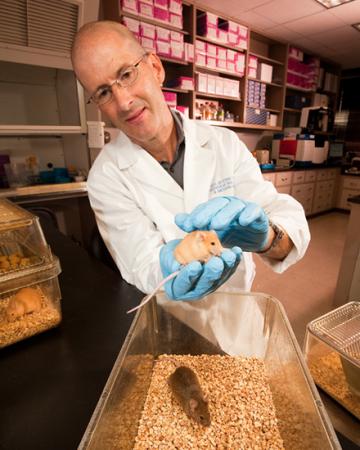Infant Overnutrition May Lead to Health Problems Later in Life

Molecular geneticist Robert Waterland examines the effects of overnutrition in mice. ARS research has shown that overnutrition during fetal stages and infancy could lead to future health problems, including type 2 diabetes. (Stephen Ausmus, D2735-1)
Scientists have known for some time that nutrition during critical periods of development can permanently affect how the body works and fights disease, including type 2 diabetes. Now, an Agricultural Research Service (ARS) cooperating scientist may have figured out the cause.
“Nutrition during fetal stages and infancy can affect your risk of various diseases as an adult,” said Robert Waterland, professor of pediatrics-nutrition at ARS’s Children’s Nutrition Research Center at Baylor College of Medicine in Houston, TX. “The fundamental mechanism we focus on is epigenetics.”
Epigenetics is the study of the molecular mechanisms established in early development that stabilize specific gene expression within cells. One example of epigenetics, Waterland said, is that essentially all cells in the body contain the same DNA – the entire genome – yet liver cells, brain cells, muscle cells, etc., all express very different subsets of genes. The endocrine pancreas, which produces insulin, is no exception.
Waterland’s research focuses on DNA methylation, a naturally occurring process in which DNA molecules are modified in ways that affect gene expression. Previous research has shown that people with type 2 diabetes have altered DNA methylation at specific genes in the insulin-producing portion of the pancreas, known as the Islets of Langerhans. Insulin is a hormone that regulates the body’s use of sugar.
The research team used mice to study the effect of early postnatal nutrition on DNA methylation in islets. Researchers separated mice at birth and reorganized the litter sizes before fostering them to mother mice. Mice in normal-sized litters of nine pups fed normally, while mice in smaller litters of four pups had access to all the mother’s milk they wanted – essentially, an all-you-can-eat buffet. At weaning, the pups from the smaller litters were overnourished and overweight.
But that’s not all; the DNA methylation levels in the pancreatic islets of the overnourished mice were similar to those of middle-aged mice. “Our interpretation is that postnatal overnutrition causes accelerated epigenetic aging in the islets,” Waterland said. “Since the ability to regulate blood sugar declines with age, this premature epigenetic aging may help explain how overnutrition during infancy increases the risk of diabetes later in life.”
Waterland noted that he could not make human health and nutritional recommendations based on a single mouse study. Still, the striking similarities in structure and function of mouse and human Islets of Langerhans emphasize the need for more research, especially for older people who may struggle with weight and health issues.
“We still have a lot to learn about these complex processes,” he said, “but one promising new insight is that as islets age, their methylation profile seems to shift. I think this might present opportunities for pharmacological interventions to slow or even reverse epigenetic aging in the islets in adulthood, if we can understand it.
“This is just a mouse study, and we need to explore how all of this works in humans. The big breakthrough is that we were able to show there are programmed, developmental processes that occur within specific cells in the Islets of Langerhans – and that nutrition during development can influence them – with permanent consequences.”
This research was published in Environmental Epigenetics. – By Scott Elliott, ARS Office of Communications.
You May Also Like:

